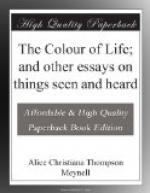Ours is a summer full of voices, and therefore it does not so need the sound of rushes; but they are most sensitive to the stealthy breezes, and betray the passing of a wind that even the tree-tops knew not of. Sometimes it is a breeze unfelt, but the stiff sedges whisper it along a mile of marsh. To the strong wind they bend, showing the silver of their sombre little tassels as fish show the silver of their sides turning in the pathless sea. They are unanimous. A field of tall flowers tosses many ways in one warm gale, like the many lovers of a poet who have a thousand reasons for their love; but the rushes, more strongly tethered, are swept into a single attitude, again and again, at every renewal of the storm.
Between the pasture and the wave, the many miles of rushes and reeds in England seem to escape that insistent ownership which has so changed (except for a few forests and downs) the aspect of England, and has in fact made the landscape. Cultivation makes the landscape elsewhere, rather than ownership, for the boundaries in the south are not conspicuous; but here it is ownership. But the rushes are a gipsy people, amongst us, yet out of reach. The landowner, if he is rather a gross man, believes these races of reeds are his. But if he is a man of sensibility, depend upon it he has his interior doubts. His property, he says, goes right down to the centre of the earth, in the shape of a wedge; how high up it goes into the air it would be difficult to say, and obviously the shape of the wedge must be continued in the direction of increase. We may therefore proclaim his right to the clouds and their cargo. It is true that as his ground game is apt to go upon his neighbour’s land to be shot, so the clouds may now and then spend his showers elsewhere. But the great thing is the view. A well-appointed country-house sees nothing out of the windows that is not its own. But he who tells you so, and proves it to you by his own view, is certainly disturbed by an unspoken doubt, if his otherwise contented eyes should happen to be caught by a region of rushes. The water is his—he had the pond made; or the river, for a space, and the fish, for a time. But the bulrushes, the reeds! One wonders whether a very thorough landowner, but a sensitive one, ever resolved that he would endure this sort of thing no longer, and went out armed and had a long acre of sedges scythed to death.
They are probably outlaws. They are dwellers upon thresholds and upon margins, as the gipsies make a home upon the green edges of a road. No wild flowers, however wild, are rebels. The copses and their primroses are good subjects, the oaks are loyal. Now and then, though, one has a kind of suspicion of some of the other kinds of trees—the Corot trees. Standing at a distance from the more ornamental trees, from those of fuller foliage, and from all the indeciduous shrubs and the conifers (manifest property, every one), two or three translucent aspens, with which the very sun and the breath of earth are entangled, have sometimes seemed to wear a certain look—an extra-territorial look, let us call it. They are suspect. One is inclined to shake a doubtful head at them.




